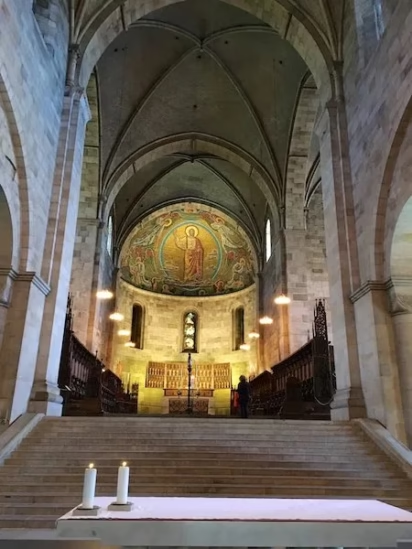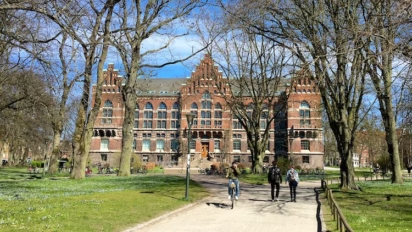The romantic university town Lund in Sweden is an easy and interesting day-trip destination from Copenhagen, CPH Airport, or Malmö.
Lund is the best day-trip destination in Sweden from Copenhagen. This picturesque small town is one of the oldest cities in Sweden and is famous for its large university, impressive Romanesque cathedral, the Kulturen open-air museum, a variety of further museums, lovely parks, and a relaxed attitude to life. Nearly half of Lund’s population is students making it a lively town in term but peacefully quiet during the vacations. Lund may be reached within an hour from Copenhagen by car or train. Day-trip tours from Copenhagen are seasonal with most including Malmö and even Kronborg.
Top Sights to See in Lund near Malmö in Sweden
Lund was founded around 990 by Danish King Svend Tveskæg (“fork beard”) but is now mostly famous for its university and Scandinavia’s largest Romanesque cathedral. Lund University was formally established in 1666 making it the second oldest in Sweden (after Uppsala) but with more than 40,000 students the largest in Scandinavia.
On a day trip, many travelers may find Lund a more interesting destination to visit than nearby Malmö (Malmø in Danish). Malmö has a compact old town and interesting museums but is the third-largest city in Sweden.
In contrast, Lund is a small university town with around 80,000 inhabitants. Its pretty historic old town center is easy to enjoy on a day trip from Copenhagen.
Lund is only 10 minutes by frequent train from Malmö with many options available for travelers from Copenhagen or other cities in Sweden.
Domkyrkan – Lund’s Romanesque Cathedral
The most obvious sight in Lund is the magnificent, triple-nave 12th-century Romanesque cathedral. This is the most impressive Romanesque building in northern Europe, although the two 55-m high towers are 19th-century additions. In contrast to the famous brick Gothic churches of Northern Europe, Lund Cathedral is in traditional sandstone with clear Rhenish architectural influences.
The church is also famous for its large astrological clock – a masterpiece of 15th-century engineering. The mechanism is complicated but the performance is simple: two knights clashing swords are followed by a procession led by the Three Kings marching around the Madonna with child. During the performance, two trumpeters, actually the smallest of the five organs in the church, play “In dulci jubilo”. If near the church at noon and 15:00 (13:00 and 16:00 on Sundays) it is worth seeing but hardly worth scheduling a visit around the minute-long performance.
The 15th-century oak choir stalls are amongst the largest and most impressive in Europe from this period. The carved altarpiece with 40 figures is from 1398 and is amongst the oldest Gothic retables in Sweden.
The large 1920s mosaic in the apse with a 6-m Christ is as much of Lund historicist in origin. Byzantine-style mosaics were in vogue in Europe in the late 19th, early 20th centuries. Some of the finest may be seen in Charlemagne’s Imperial cathedral (Kaiserdom) in Aachen, Germany.
Most of the rest of the church is without any art or decorations. However, do peak into the crypt with its 18 columns. Two of the pillars have figures hugging the columns. According to legend, these are the giant Finn and his wife. They helped build the church but tried to destroy it when they felt cheated. However, they turned to stone before they could tumble the pillars.
Historicist Buildings of Lund University in Sweden
Many of the buildings in Lund are historicist creations of the late 19th and early 20th centuries. The Kungshus (King’s House) with its prominent round tower looks like a prime example but this building actually is from the 16th century. It was erected by Danish King Frederik II and housed the university for two centuries.
The nearby white neo-classical Universitetshuset was built in 1882 as the main university building. The frogs on the large fountain symbolize the four original faculties: theology, law, medicine, and philosophy.
From here northeastwards are several blocks of university buildings. The neo-Gothic university library building in the middle of a park is interesting but more impressive is its collection: its 100,000 m of shelf space has more than 3 million books including manuscripts from the 12th century.
The university uses the nearby botanical garden so the variety of flora is extensive. Around 7000 species are planted in the gardens with the glass greenhouses (open daily from 11:00 to 15:00) divided into nine different climate zones.
Museums in Lund, Sweden
Lund has several museums but the large Kulturen complex is the easiest to enjoy. This cultural-historical open-air museum complex in the heart of the city has around 40 houses – some in their original position while others were relocated from various parts of southern Sweden. These are furnished as would have been typical and thus show how people of various social and economic classes would have lived from the Middle Ages to around 1930.
In addition to Kulturen, Lund has several further interesting museums to explore:
- The Livetsmuseum (life museum) focuses on the human body. The presentation incorporates historic and modern equipment and theories to illustrate health, diseases, and treatments through the ages. It has many interactive stations.
- The Skissernasmuseum (sketches museum) illustrates how artworks are made. Models and sketches show the whole process from conception to the final physical production of a work of art.
- The Historiska Museet (history museum) is the second-largest archaeological museum in Sweden and has an important collection of prehistoric finds, artifacts from classical antiquity and medieval religious objects and art.
- Lunds Kunsthall shows modern art both by local and international artists.
- The Drottens Kyrkoruin (free admission) shows the medieval ruins of the second largest of 27 churches that operated in Lund prior to the Reformation. (Entrance via the restaurant Gattostretto!)
- The Vattenhallen Science Center explains science, especially to early teens, through practical experiments. It is usually open on weekend afternoons and is mostly in Swedish (although many of the presenters speak perfect English).
Transportation to Lund in Sweden from Copenhagen
Getting to Lund in Sweden for a day-trip visit is easy by car or train from Copenhagen (or on direct trains from Malmö, Gothenburg, or Stockholm). Passport controls are often done when traveling from Denmark but add surprisingly little to travel time, especially when arriving by car.
Traveling to Lund by Car from Denmark
Driving to Lund is easy. From Copenhagen Airport, cross the Øresund bridge – actually first a tunnel and then the famous bridge – and continue on the E27 / E6 highway around Malmö to Lund. Parking garages in Lund are well marked – simply follow signs to the center.
Crossing the Øresund Bridge by car is pricy but cheaper if paid online in advance and cheap savings deals are often available for day trips. If planning to cross the bridge more than once per year, sign up for a BroPass. Payment (and passport control if any) are always done on the Swedish side only.
Drivers may easily venture further into Sweden to visit the Ikea Museum inside the original Ikea store in Almhült. The Ikea Hotel is a pleasant option for the night too.
Day Trips Tours from Copenhagen to Lund and Malmö
Day-trip tours from Copenhagen to Lund and Malmö are seasonal but some are usually available year-round. Most tours include a visit to Malmö as well. Better value might be a full day-trip tour that includes not only Lund and Malmö but also a visit to Kronborg (Hamlet’s Elsinore) in Helsingør. This trip crosses the Øresund by ferry (Helsingør – Helsingborg) and by bridge (Malmö – Copenhagen).
By Train to Lund in Sweden from Copenhagen in Denmark
Trains are available usually three times per hour from Copenhagen to Lund. Traveling time to Lund is just over 50 minutes from Copenhagen Central Station (København K) and less than 40 minutes from the airport. Tickets are easily bought from any station or try Omio, which may even list a few bus options.
Passport controls on journeys to Sweden are often done on the train and in Sweden. It is no longer necessary to get off the train for passports to be checked at Copenhagen Airport. Danish checks are sometimes made at the airport but once again on the train.
Lund train station is three blocks to the west of the old town center. The Lund Tourist Information office in the Stadshallen is a good first stop. Ask for the handy map with a walking route via all the main sights in the old town center area.
Lund is mostly seen on day trips from Copenhagen (or Malmö) but it has a number of pleasant hotels too that may offer cheaper prices on a quiet night. See how TripAdvisor users rate hotels in Lund (Sweden). The Grand Hotel Lund is a traditional late 19th-century historicist hotel near the train station but better value may be available in the less characterful modern hotels or in nearby Malmö.









